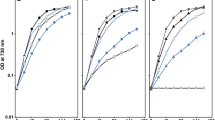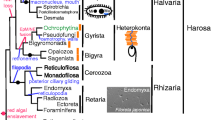Abstract
The bop gene codes for the membrane protein bacterio-opsin (BO), which on binding all-trans-retinal, constitutes the light-driven proton pump bacteriorhodopsin (BR) in the archaebacterium Halobacterium salinarium Footnote 1. This gene was cloned in a yeast multi-copy vector and expressed in Saccharomyces cerevisiae under the control of the constitutive ADH1 promoter. Both the authentic gene and a modified form lacking the precursor sequence were expressed in yeast. Both proteins are incorporated into the membrane in S. cerevisiae. The presequence is thus not required for membrane targeting and insertion of the archaebacterial protein in budding yeast, or in the fission yeast Schizosaccharomyces pombe, as has been shown previously. However, in contrast to S. pombe transformants, which take on a reddish colour when all-trans-retinal is added to the culture medium as a result of the in vivo regeneration of the pigment, S. cerevisiae cells expressing BO do not take on a red colour. The precursor of BO is processed to a protein identical in size to the mature BO found in the purple membrane of Halobacterium. The efficiency of processing in S. cerevisiae is dependent on growth phase, as well as on the composition of the medium and on the strain used. The efficiency of processing of BR is reduced in S. pombe and in a retinal-deficient strain of H. salinarium, when retinal is present in the medium.
Similar content being viewed by others
Notes
The designation H. salinarium instead of the former designation H. halobium is used throughout this paper following the classification of Tindall (1992)
References
Beach D, Piper M, Shall S (1980) Isolation of chromosomal origins of replication in yeast. Nature 284:185–187
Chan CSM, Tye B (1980) Autonomously replicating sequences in Saccharomyces cerevisiae. Proc Natl Acad Sci USA 77:6329–6333
Chevallier MR, Bloch JC, Lacroute F (1980) Transcriptional and translational expression of a chimeric bacterial-yeast plasmid in yeasts. Gene 11:11–19
Dunn R, McCoy J, Simsek M, Majumdar A, Chang SH, RajBhandary UL, Khorana HG (1981) The bacteriorhodopsin gene. Proc Natl Acad Sci USA 78:6744–6748
Dunn R, Hackett NR, McCoy J, Kimura K, Khorana HG (1987) Structure-function studies on bacteriorhodopsin. I. Expression of the bacterio-opsin gene in Escherichia coli. J Biol Chem 262:9246–9254
Fasano O, Hurt E, Serrano R, Tollervey D (1991) EMBO Practical Course, Handbook: Cellular and molecular biology of yeast, EMBL, Heidelberg FRG
Ferrando E, Schweiger U, Oesterhelt D (1993) Homologous bacterio-opsin-encoding gene expression via site-specific vector integration. Gene 125:41–47
Frevert U, Lange M, Wrede P (1989) Immunoelectron microscopic study on the biogenesis of bacteriorhodopsin. Endocytobiosis Cell Res 6:171–182
Gropp R, Gropp F, Betlach MC (1992) Association of the halobacterial 7S RNA to the polysome correlates with expression of the membrane protein bacterioopsin. Proc Natl Acad Sci USA 89:1204–1208
Hildebrandt V, Ramezani-Rad M, Swida U, Wrede P, Grzesiek S, Primke M, Büldt G (1989) Genetic transfer of the pigment bacteriorhodopsin in the eukaryote Schizosaccharomyces pombe. FEBS Lett 243:137–140
Hildebrandt V, Polakowski F, Büldt G (1991) Purple fission yeast: overexpression and processing of the pigment bacteriorhodopsin. Photochem Photobiol 54:1009–1016
Hildebrandt V, Fendler K, Heberle J, Hoffmann A, Bamberg E, Büldt G (1993) Bacteriorhodopsin expressed in Schizosaccharomyces pombe pumps protons through the plasma membrane. Proc Natl Acad Sci USA 90:3578–3582
Himeno M, Shibata T, Kawahara Y, Hanaoka Y, Komano T (1984) Effect of polyethylene glycol in plasmid DNA solution on transformation of CaCl2 treated Escherichia coli cells. Agric Biol Chem 48:657–662
Hinnen A, Hicks JB, Fink GR (1978) Transformation of yeast. Proc Natl Acad Sci USA 75:1929–1933
Ito H, Fukuda Y, Murata K, Kimura A (1983) Transformation of intact yeast cells treated with alkali ions. J Bacteriol 153:163–168
Karnik S, Doi T, Molday R, Khorana HG (1990) Expression of the archaebacterial bacterio-opsin gene with and without signal sequences in Escherichia coli: the expressed proteins are located in the membrane but bind retinal poorly. Proc Natl Acad Sci USA 87:8955–8959
King K, Dohlman HG, Thorner J, Caron MG, Lefkowitz RJ (1990) Control of yeast mating signal transduction by a mammalian β2-adrenergic receptor and Gs α subunit. Science 250:121–123
Kopetzki E, Buckel P, Schumacher G (1989) Cloning and characterization of baker's yeast α-glucosidase: over-expression in a yeast strain devoid of vacuolar proteinases. Yeast 5:1–24
Lang-Hinrichs C, Berndorff D, Seefeldt C, Stahl U (1989) G418 resistance in the yeast Saccharomyces cerevisiae: comparison of the neomycin resistance genes from Tn5 and Tn903. Appl Microbiol Biotechnol 30:388–394
Lang-Hinrichs C, Dössereck C, Fath I, Stahl U (1990) Use of the Tn903 neomycin resistance gene for promoter analysis in the fission yeast Schizosaccharomyces pombe. Curr Genet 18:511–516
Miercke LJW, Ross PE, Stroud RM, Dratz EA (1989) Purification of bacteriorhodopsin and characterization of mature and partially processed forms. J Biol Chem 264:7531–7535
Ni B, Chang M, Duschl A, Lanyi J, Needleman R (1990) An efficient system for the synthesis of bacteriorhodopsin in Halobacterium halobium. Gene 90:169–172
Oesterhelt D, Stoeckenius W (1971) Rhodopsin-like protein from the purple membrane of Halobacterium halobium. Nature 233:149–152
Oesterhelt D, Stoeckenius W (1974) Isolation of the cell membrane of Halobacterium halobium and its fractionation into red and purple membrane. Methods Enzymol 31:667–678
Pardo L, Ballesteros JA, Osman R, Weinstein H (1992) On the use of the transmembrane domain of bacteriorhodopsin as a template for modeling the three-dimensional structure of guanine nucleotide-binding regulatory protein-coupled receptors. Proc Natl Acad Sci USA 89:4009–4012
Payette P, Gossard F, Whiteway M, Dennis M (1990) Expression and pharmacological characterization of the human M1 muscarinic receptor in Saccharomyces cerevisiae. FEBS Lett 266:21–25
Rendueles PS, Wolf DH (1988) Proteinase function in yeast: biochemical and genetic approaches to a central mechanism of post-translational control in the eukaryote cell. FEMS Microbiol Rev 54:17–46
Ruohonen L, Penttilä M, Keränen S (1991) Optimization of Bacillus α-amylase production by Saccharomyces cerevisiae. Yeast 7:337–346
Sander P (1992) Expression of membrane-localized receptors in the yeast Saccharomyces cerevisiae. PhD Thesis, Johann-Wolfgang-Goethe-Universität, Frankfurt
Schwencke J (1991) Vacuoles, internal membraneous systems and vesicles. In: Rose AH, Harrison JS (eds) The yeasts, vol 4. Academic press, London, pp 347–432
Tindall BJ (1992) The family Halobacteriaceae. In: Balows A, Trüper HG, Dworkin M, Harder W, Schleifer KH (eds) The prokaryotes. Springer, New York, pp 769–808
Wölfer U, Dencher NA, Büldt G, Wrede P (1988) Bacterioopsin precursor is processed in two steps. Eur J Biochem 174:51–57
Author information
Authors and Affiliations
Additional information
Communicated by C.P. Hollenberg
Rights and permissions
About this article
Cite this article
Lang-Hinrichs, C., Queck, I., Büldt, G. et al. The archaebacterial membrane protein bacterio-opsin is expressed and N-terminally processed in the yeast Saccharomyces cerevisiae . Molec. Gen. Genet. 244, 183–188 (1994). https://doi.org/10.1007/BF00283521
Received:
Accepted:
Issue Date:
DOI: https://doi.org/10.1007/BF00283521




